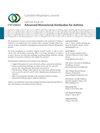APACHEⅱ和SOFA评分对重症监护病房COVID-19患者死亡率的预测价值
IF 2.1
4区 医学
Q3 RESPIRATORY SYSTEM
引用次数: 35
摘要
背景自2019年12月以来,新冠肺炎大流行已成为一个全球性难题。急性生理学和慢性健康评估(APACHE II)和连续器官衰竭评估(SOFA)评分等标准评分是否准确预测新冠肺炎死亡率或是否需要新评分?我们旨在评估APACHE II和SOFA评分对危重新冠肺炎患者死亡率的预测价值。方法在一项队列研究中,我们招募了伊玛目霍梅尼综合医院重症监护室收治的204名确诊的新冠肺炎患者。第一天的APACHE II和每日SOFA评分。主要结果是非存活组和存活组的死亡率,次要结果是器官功能障碍。通过分类变量的卡方检验和连续变量的独立样本t检验对两组存活和非存活患者进行比较。我们使用逻辑回归模型来估计高APACHE II和SOFA评分的死亡率风险。结果在204例重症新冠肺炎患者中,114例(55.9%)患者过期,169例(82.8%)患者至少有一种合并症,其中103例(60.9%)患者未存活(P=0.002)。非存活组的平均APACHE II和平均SOFA评分显著高于存活组(14.4 ± 5.7对9.5 ± 5.1,P≤0.001,7.3 ± 3.1与3.1 ± 1.1,P≤0.001)。SOFA的曲线下面积为89.5%,APACHE II评分为73%。呼吸系统疾病和恶性肿瘤是糖尿病和高血压死亡率的危险因素(分别为P=0.004和P=0.007)。结论每日SOFA是比APACHE II更好的预测新冠肺炎危重患者死亡率的指标。但他们无法高精度地预测死亡。我们需要在考虑预后因素和每日评估临床状况变化的情况下进行新的评分。本文章由计算机程序翻译,如有差异,请以英文原文为准。
Mortality Predictive Value of APACHE II and SOFA Scores in COVID-19 Patients in the Intensive Care Unit
Background COVID-19 pandemic has become a global dilemma since December 2019. Are the standard scores, such as acute physiology and chronic health evaluation (APACHE II) and sequential organ failure assessment (SOFA) score, accurate for predicting the mortality rate of COVID-19 or the need for new scores? We aimed to evaluate the mortality predictive value of APACHE II and SOFA scores in critically ill COVID-19 patients. Methods In a cohort study, we enrolled 204 confirmed COVID-19 patients admitted to the intensive care units at the Imam Khomeini hospital complex. APACHE II on the first day and daily SOFA scoring were performed. The primary outcome was the mortality rate in the nonsurvived and survived groups, and the secondary outcome was organ dysfunction. Two groups of survived and nonsurvived patients were compared by the chi-square test for categorical variables and an independent sample t-test for continuous variables. We used logistic regression models to estimate the mortality risk of high APACHE II and SOFA scores. Result Among 204 severe COVID-19 patients, 114 patients (55.9%) expired and 169 patients (82.8%) had at least one comorbidity that 103 (60.9%) of them did not survive (P=0.002). Invasive mechanical ventilation and its duration were significantly different between survived and nonsurvived groups (P ≤ 0.001 and P=0.002, respectively). Mean APACHE II and mean SOFA scores were significantly higher in the nonsurvived than in the survived group (14.4 ± 5.7 vs. 9.5 ± 5.1, P ≤ 0.001, 7.3 ± 3.1 vs. 3.1 ± 1.1, P ≤ 0.001, respectively). The area under the curve was 89.5% for SOFA and 73% for the APACHE II score. Respiratory diseases and malignancy were risk factors for the mortality rate (P=0.004 and P=0.007, respectively) against diabetes and hypertension. Conclusion The daily SOFA was a better mortality predictor than the APACHE II in critically ill COVID-19 patients. But they could not predict death with high accuracy. We need new scoring with consideration of the prognostic factors and daily evaluation of changes in clinical conditions.
求助全文
通过发布文献求助,成功后即可免费获取论文全文。
去求助
来源期刊

Canadian respiratory journal
医学-呼吸系统
CiteScore
4.20
自引率
0.00%
发文量
61
审稿时长
6-12 weeks
期刊介绍:
Canadian Respiratory Journal is a peer-reviewed, Open Access journal that aims to provide a multidisciplinary forum for research in all areas of respiratory medicine. The journal publishes original research articles, review articles, and clinical studies related to asthma, allergy, COPD, non-invasive ventilation, therapeutic intervention, lung cancer, airway and lung infections, as well as any other respiratory diseases.
 求助内容:
求助内容: 应助结果提醒方式:
应助结果提醒方式:


